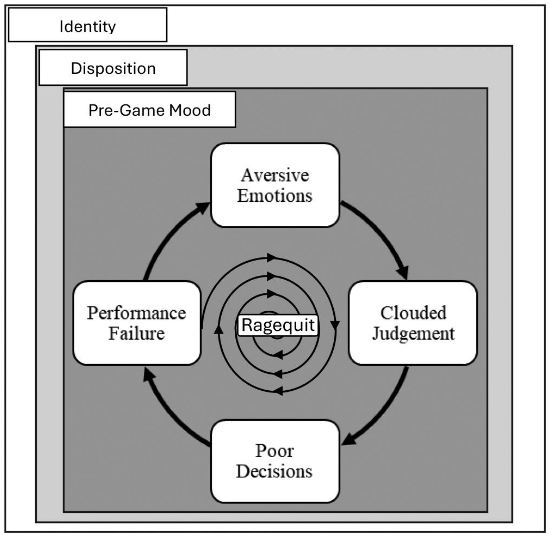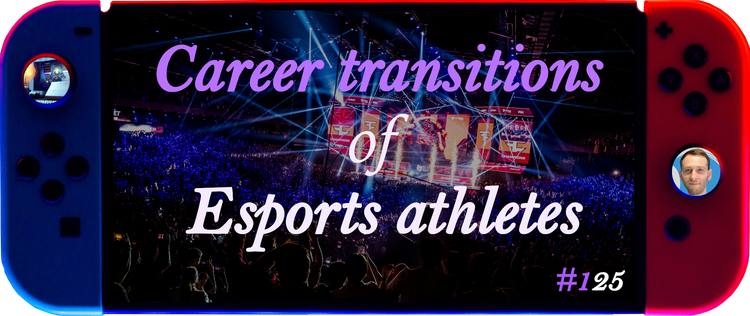From Tilt to Ragequit: The Psychology Behind Losing Control

Tilt and ragequitting are common among gamers. But what exactly causes people to tilt and leave their teammates all alone? And what can we do about it? Here's what the science says.
• Tilt and ragequitting are things every gamer knows inside out — and both have many negative effects.
• "“tilt”... describe[s] a cyclical phenomenon whereby negative emotions stemming from failures lead people to adopt poorer performance strategies resulting in more failures..." [1]
• The tilt cycle includes: failed performance expectations -> negative emotions -> clouded judgement -> poor decisions -> failed performance...
• Ragequitting occurs when players are at a (too) high level of tilt.
• Way to stop the cycle are: helping the player that is behind, slowing down the pace of the game, and taking a break after the match.
The term "tilt" originally comes from professional poker, where negative emotions cause a loss of control and lead to pathological gambling. This often happens when Poker players are in disbelief at how ‘unlucky’ they are. Then, what follows is a more aggressive playstyle to make up for the losses. This emotional affect is particularly strong in people who are more emotionally sensitive.
"“tilt”... describe[s] a cyclical phenomenon whereby negative emotions stemming from failures lead people to adopt poorer performance strategies resulting in more failures..." [1]
Every gamer has experienced tilt. In a previous study, players stated to be more often tilted when playing for competitive reasons rather than for fun. As we have seen in earlier episodes, the performance of teammates is a major source of stress. This, at least in League of Legends, is also the case for tilt. If your top laner is Emerald Adam, 0:3 at min. 8, you're likely to not be very happy about that.
Such negative emotions, according to players, go hand in hand with disrupted concentration and behavioral repercussions (a polite way of saying ‘being toxic and aggressive’).
"Another emotional phenomenon relevant to videogames is ragequitting, which occurs when a gamer’s overwhelming anger or frustration leads them to suddenly remove themselves from the game prior to its conclusion. [1]
"...ragequitting [is] an expression of frustration stemming from a series of personal failures, incompetent teammates, or technical problems." Big gaming companies have caught up with ragequitting behavior and adjusted their algorithms so that these players are placed in lower-priority matchmaking queues and lobbies.
😡 Why You Tilt (and How to Fix It)
"The overall experience of tilt was described as a cyclical phenomenon wherein performance failures prompted aversive emotions that clouded judgements and negatively affected future performance opportunities." [1]
The players stated that the cycle of tilt begins after "underperforming one’s own personal or team’s expectations." [1] Let's be honest, we always know it's the other guys' fault, right? Right! Below, you can see the cycle of tilt and, ultimately, climaxes into ragequitting.

After you — ah, sorry, your teammates — underperform, players start feeling anger, frustration, or sadness (depending on whether they blame themselves or their teammates). As a result, this affective state of negativity affects their judgment.
“I go for a lot more risky plays that I know won’t pay off, but I’m on that gambler’s fallacy type thing where I’m like: “Well, last game was super unlucky, so I have to get lucky this game” [1]
This kind of clouded judgement was, according to the players interviewed, a source of bad decision-making—doing things they usually wouldn't.
As a player, one of your goals is to climb the ladder. However, tilt and ragequitting clearly doesn't contribute to this goal. So, tilted Emerald Adam should just take a break, right? Yes, but this goes back to an earlier episode about continuing to play, although you know you shouldn't (or don't even want)—Just One More Game!
Tilt, clouded judgement, and queuing up ultimately leads to a ragequit, if the cycle of tilt is left unmanaged. "I feel like once you reach a certain level of tilt, you will, you almost guarantee a ragequit for most people." [1]
So what does the interviewed players say about mitigating or countering the rising level of tilt? The professional players interviewed mentioned applying strategies such as a tactical pause, adjusting their gameplay tempo, or setting pre-commitment rules.
By adjusting the tempo, they refer to slowing down the pace of the game. Also, they highlighted helping the player who's behind and causing their teammates to tilt. You make a conscious effort to help them get back into the game.
🥡 The Takeaways
Tilt is just part of the game—of every game. However, if you realize you're tilted, try to take a step back. This includes in the game—changing the pace, helping your teammates (I know, it's hard)—but also after the match is done—take a small break and give it a minute. Maybe that minute will also have you not queue up the next game, likely saving your precious ladder points. It may also have you go to bed half an hour earlier and not feeling tired the next day.
Hope you didn't tilt and ragequit this episode. 😅Best,
Christian 🙂







